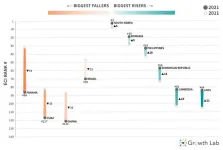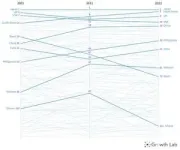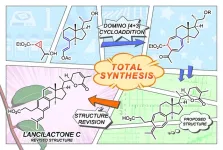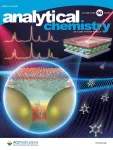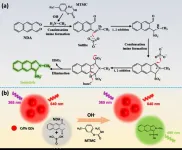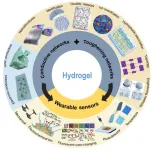(Press-News.org) Cambridge, MA – China, India, Indonesia, Uganda, and Vietnam are projected to be among the fastest-growing economies for the coming decade, according to researchers at the Growth Lab at Harvard University. The new growth projections presented in The Atlas of Economic Complexity include the first detailed look at 2021 trade data, which reveal continued disruptions from the uneven economic recovery to the global pandemic. China is expected to be the fastest-growing economy per capita, although its growth rate is smaller than gains seen over the past decade.
Growth over the coming decade is projected to take off in three growth poles, East Asia, Eastern Europe, and East Africa. Several Asian economies already hold the necessary economic complexity to drive the fastest growth over the coming decade to 2031, led by China, Cambodia, Vietnam, Indonesia, Malaysia, and India. In East Africa, several economies are expected to experience rapid growth, though driven more by population growth than gains in economic complexity, which include Uganda, Tanzania, and Mozambique. Eastern Europe holds strong growth potential for its continued advances in economic complexity, with Georgia, Lithuania, Belarus, Armenia, Latvia, Bosnia and Herzegovina, Romania, and Albania all ranking in the projected top 15 economies on a per capita basis. Outside these growth poles, the projections also show potential for Egypt to achieve more rapid growth. Other developing regions face more challenging growth prospects by making fewer gains in their economic complexity, including Latin America and the Caribbean and West Africa.
"Countries that have diversified their production into more complex sectors, like Vietnam and China, are those that will lead global growth in the coming decade," said Ricardo Hausmann, director of the Growth Lab, professor at the Harvard Kennedy School (HKS), and the leading researcher of The Atlas of Economic Complexity. "China and Vietnam already realized many of the income gains from their increased complexity. Nevertheless, they remain more complex than expected for their income level, so will remain global growth poles."
The Economic Complexity Index (ECI) captures the diversity and sophistication of the productive capabilities embedded in the exports of each country. The researchers place the diversity of productive knowledge—or knowhow—that a society has at the heart of the economic development process. Economic growth requires the accumulation of new knowhow and its use to diversify production into more sophisticated—aka complex—activities. ECI is able to closely explain differences in country incomes – and to predict future growth.
The Growth Lab researchers released new 2021 ECI rankings, which show remarkable stability despite uneven economic recovery and lingering pandemic effects in 2021. The ECI ranking finds the most complex countries in the world are, in order, Japan, Switzerland, South Korea, Germany, and Singapore at the top. Other notable countries include the United Kingdom at 8th, the United States at 14th, France at 17th, and China at 18th. Among the most complex countries, the greatest improvements in the rankings for the decade ending in 2021 have been made by Romania (19th), the Philippines (33rd), and South Korea (3rd). Oil prices rebounded slightly in 2021 while remaining moderate, leaving non-oil exports to feature more prominently in the export baskets of commodity economies. These economies saw an uptick in the economic complexity ranking, for the likes of Kuwait, Saudi Arabia, Qatar, and Iran, although these gains are not likely to be sustained with the rise in oil prices in 2022. Outside of commodity economies, those developing economies that have made the greatest strides in improving their complexity include Laos (84th), Cambodia (83rd), and the Dominican Republic (58th). Those countries that show the fastest declines in the complexity rankings in the past decade have failed to diversify their exports, namely Panama (86th), Cuba (117th), Ghana (121st), and Brazil (70th).
The true value of the economic complexity measure is in its accuracy in predicting future growth, which ECI has been shown to do better than any other single measure in predicting growth. By identifying those countries whose economic complexity exceeds expectations based on its income level, the researchers find a strong predictor of the countries that will grow faster in the coming decade. The Atlas of Economic Complexity features data visualizations covering over 5,000 goods and services to understand the economic dynamics and growth opportunities for every country worldwide.
END
China, Indonesia, and Vietnam lead global growth for coming decade in new Harvard Growth Lab projections
Researchers identify three growth poles: East Asia, Eastern Europe, and East Africa
2023-07-28
ELSE PRESS RELEASES FROM THIS DATE:
Researchers tickle rats to identify part of the brain critical for laughter and playfulness
2023-07-28
To study play behaviors in animals, scientists must be able to authentically simulate play-conducive environments in the laboratory. Animals like rats are less inclined to play if they are anxious or restrained, and there is minimal data on the brain activity of rats that are free to play. After getting rats comfortable with a human playmate, tickling them under controlled conditions, then measuring the rats’ squeaks and brain activity, a research team reports on July 27 in the journal Neuron that a structure in rat brains called the periaqueductal gray is essential for play and laughter.
“We know that vocalizations such as laughter are very ...
Scientists discover secret of virgin birth, and switch on the ability in female flies
2023-07-28
Scientists have pinpointed a genetic cause for virgin birth for the first time, and once switched on the ability is passed down through generations of females.
For the first time, scientists have managed to induce virgin birth in an animal that usually reproduces sexually: the fruit fly Drosophila melanogaster.
Once induced in this fruit fly, this ability is passed on through the generations: the offspring can reproduce either sexually if there are males around, or by virgin birth if there aren’t.
For most animals, reproduction is sexual - it involves a female’s egg being fertilised by a male’s sperm. ...
Uncovering how the Golgi apparatus impacts early postnatal neuron development
2023-07-28
Neurons are the cells that constitute neural circuits and use chemicals and electricity to receive and send messages that allow the body to do everything, including thinking, sensing, moving, and more. Neurons have a long fiber called an axon that sends information to the subsequent neurons. Information from axons is received by branch-like structures that fan out from the cell body, called dendrites.
Dendritic refinement is an important part of early postnatal brain development during which dendrites are tailored to make specific connections with appropriate axons. In a recently published paper, researchers present evidence showing how a mechanism within the neurons of a rodent involving ...
Total recall on HIV
2023-07-28
Kyoto, Japan -- Having control over how a dish is cooked is always a good idea. Taking a hint from the kitchen, scientists appear to have discovered a way to produce a true structure of the rare but naturally-occurring anti-HIV compound Lancilactone C from start to finish.
Its non-cytotoxicity in mammals could make this triterpenoid an ideal candidate for treating AIDS if its biological activity were clear -- and if only it were abundant in nature.
Now, a research group at Kyoto University has succeeded in ...
Scientists suggest AgNP/MoS2 nano-pocket for surface-enhanced raman spectroscopy scattering detection
2023-07-28
The research group of YANG Liangbao at the Institute of Health and Medical Technology, Hefei Institutes of Physical Science (HFIPS), Chinese Academy of Science (CAS) has recently developed a surface-enhanced Raman spectroscopy (SERMS) method to automatically capture target molecules in AgNP/MoS2 nano-pockets, which enables highly sensitive and long-duration dynamic detection of some chemical reaction processes.
The results were published in Analytical Chemistry and selected as the front cover.
Surface-enhanced Raman spectroscopy (SERS) is a kind of molecular spectroscopy with fast, highly sensitive, ...
Solving the climate crisis requires collaboration between natural and social scientists
2023-07-28
Now that the world has experienced its hottest day in history, it is more urgent than ever for natural and social scientists to work together to address the climate crisis and keep global temperature increases below 2°C. To this end, an international group of esteemed researchers recently published an innovative research paper that highlights the importance of integrating knowledge from natural and social sciences to inform about effective climate change policies and practice. They argue that the concept of tipping points can serve as a bridge ...
A nanoprobe developed for visual quantitative detection of pesticides
2023-07-28
Recently, Prof. JIANG Changlong and his research team at the Institute of Solid State Physics, Hefei Institutes of Physical Science (HFIPS) of Chinese Academy of Sciences (CAS), developed and synthesized two highly effective ratiometric fluorescence nanoprobes. These nanoprobes, when combined with the color recognition capabilities of smartphones, enabled the visual and quantitative detection of pesticides in food and environmental water.
The research has been published in Chemical Engineering Journal and ACS Sustainable Chemistry & Engineering.
Carbamate compounds ...
Retina cell breakthrough could help treat blindness
2023-07-28
Scientists have found a way to use nanotechnology to create a 3D ‘scaffold’ to grow cells from the retina –paving the way for potential new ways of treating a common cause of blindness.
Researchers, led by Professor Barbara Pierscionek from Anglia Ruskin University (ARU), have been working on a way to successfully grow retinal pigment epithelial (RPE) cells that stay healthy and viable for up to 150 days. RPE cells sit just outside the neural part of the retina and, when damaged, can cause vision to deteriorate.
It ...
The approaches to achieve high-performance wearable sensors with hydrogels
2023-07-28
This review is written by Dr. Weixing Song from the Department of Chemistry, Capital Normal University. The paper reviewed the toughness and conductive network of existing hydrogel sensors. It emphasized the development status of various hydrogel sensors and highlighted strategies to enhance their mechanical and electrical performance. The findings are valuable for designing components and structures of high-performance wearable hydrogel sensors.
The increasing demand for healthcare IoT devices drives the development of wearable electronics. Electronic skins possess softness, stretchability, and self-healing ...
Enhanced light sensitivity may contribute to Alzheimer's 'sundowning,' disease progression
2023-07-28
New Alzheimer’s research from UVA Health suggests that enhanced light sensitivity may contribute to “sundowning” – the worsening of symptoms late in the day – and spur sleep disruptions thought to contribute to the disease’s progression.
The new insights into the disruptions of the biological clock seen in Alzheimer’s could have important potential both for the development of treatments and for symptom management, the researchers say. For example, caregivers often struggle with the erratic sleep patterns caused by Alzheimer’s ...
LAST 30 PRESS RELEASES:
Research suggests nationwide racial bias in media reporting on gun violence
Revealing the cell’s nanocourier at work
Health impacts of nursing home staffing
Public views about opioid overdose and people with opioid use disorder
Age-related changes in sperm DNA may play a role in autism risk
Ambitious model fails to explain near-death experiences, experts say
Multifaceted effects of inward foreign direct investment on new venture creation
Exploring mutations that spontaneously switch on a key brain cell receptor
Two-step genome editing enables the creation of full-length humanized mouse models
Pusan National University researchers develop light-activated tissue adhesive patch for rapid, watertight neurosurgical sealing
Study finds so-called super agers tend to have at least two key genetic advantages
Brain stimulation device cleared for ADHD in the US is overall safe but ineffective
Scientists discover natural ‘brake’ that could stop harmful inflammation
Tougher solid electrolyte advances long-sought lithium metal batteries
Experts provide policy roadmap to reduce dementia risk
New 3D imaging system could address limitations of MRI, CT and ultrasound
First-in-human drug trial lowers high blood fats
Decades of dredging are pushing the Dutch Western Scheldt Estuary beyond its ecological limits
A view into the innermost workings of life: First scanning electron microscope with nanomanipulator inaugurated in hesse at Goethe University
Simple method can enable early detection and prevention of chronic kidney disease
S-species-stimulated deep reconstruction of ultra-homogeneous CuS nanosheets for efficient HMF electrooxidation
Mechanical and corrosion behavior of additively manufactured NiTi shape memory alloys
New discovery rewrites the rules of antigen presentation
Researchers achieve chain-length control of fatty acid biosynthesis in yeast
Water interactions in molecular sieve catalysis: Framework evolution and reaction modulation
Shark biology breakthrough: Study tracks tiger sharks to Maui mating hub
Mysterious iron ‘bar’ discovered in famous nebula
World-first tool reduces harmful engagement with AI-generated explicit images
Learning about public consensus on climate change does little to boost people’s support for action, study shows
Sylvester Cancer Tip Sheet for January 2026
[Press-News.org] China, Indonesia, and Vietnam lead global growth for coming decade in new Harvard Growth Lab projectionsResearchers identify three growth poles: East Asia, Eastern Europe, and East Africa
